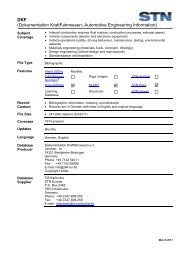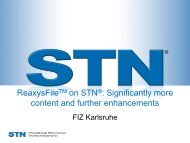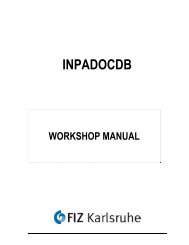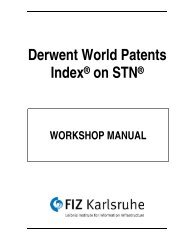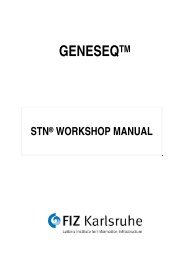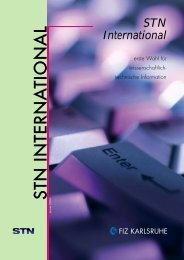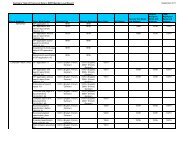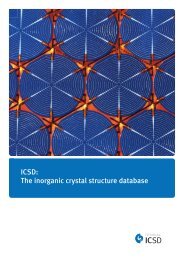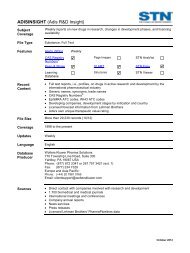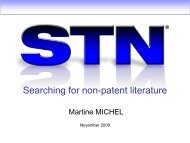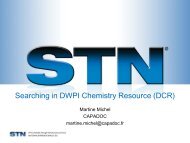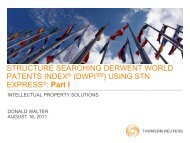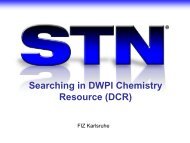Ncbi blast similarity searching in usgene - FIZ Karlsruhe
Ncbi blast similarity searching in usgene - FIZ Karlsruhe
Ncbi blast similarity searching in usgene - FIZ Karlsruhe
You also want an ePaper? Increase the reach of your titles
YUMPU automatically turns print PDFs into web optimized ePapers that Google loves.
Frequently Asked Questions (FAQ) concern<strong>in</strong>g sequence <strong>similarity</strong> <strong>search<strong>in</strong>g</strong> us<strong>in</strong>g<br />
NCBI BLAST ® and GETSIM <strong>in</strong> USGENE ® on STN ®<br />
NCBI BLAST ® SIMILARITY SEARCHING IN USGENE ® ..............................................................3<br />
1. Q: What are the search limits for BLAST ?....................................................................................................3<br />
2. Q: How do I upload sequences longer than the 256 character l<strong>in</strong>e length limit?......................................3<br />
3. Q: How can I view an uploaded sequence before I submit it to BLAST ? ..................................................3<br />
4. Q: Do spaces, carriage returns and header characters, from formats such as FASTA or WIPO ST.25,<br />
<strong>in</strong> uploaded queries harm the sequence search ? ...................................................................................4<br />
5. Q: How can I alter the advanced options for a BLAST search ? How do they effect the answer set ?...4<br />
6. Q: What does "EXCEEDS MAXIMUM FIELD LENGTH, WILL BE SEARCHED AS 'XXXXX'" mean when I<br />
use the Query command and what can I do about it ?.............................................................................4<br />
7. Q: What does the graphic summary appear<strong>in</strong>g after a <strong>similarity</strong> search represent ? ..............................5<br />
8. Q: What is the message " Maximum answer limit of 10,000 reached” try<strong>in</strong>g to convey, and do I need<br />
to be concerned about it ? ..........................................................................................................................5<br />
9. Q: How do I display BLAST alignments and what <strong>in</strong>formation do they provide ? ....................................5<br />
10. Q: Is it possible to limit BLAST searches <strong>in</strong> USGENE with patent text, date terms and to preferred<br />
document types – especially to issued U.S. patents ? ............................................................................6<br />
11. Q: Unlike GETSIM, the BLAST search method does not report a Query Self Score value. Why is that<br />
and is there anyway to calculate this myself? ..........................................................................................6<br />
12. Q: How can I calculate the <strong>similarity</strong> percentage of the aligned sequence ? ............................................6<br />
13. Q: How can I see only one result per patent family but sorted by <strong>similarity</strong> ? ..........................................7<br />
14. Q: How many BATCH searches can be queued up at any one time? .........................................................7<br />
15. Q: Will I be billed for a result if I delete it from the batch queue without retriev<strong>in</strong>g it ? ...........................7<br />
16. Q: What status is possible for a BATCH and how long are the results available ?...................................7<br />
17. Q: I would like to monitor patent<strong>in</strong>g activities for biosequences. Can I run a BLAST search with<strong>in</strong><br />
STN's standard SDI command procedure ? ..............................................................................................8<br />
18. Q: Does the ALERT search work any differently from the standard BLAST search ?..............................8<br />
19. Q: Are the search options BATCH and ALERT also available for BLAST ?...............................................8<br />
20. Q: Which <strong>similarity</strong> matrices are used by the BLAST algorithm?...............................................................8
Frequently Asked Questions (FAQ) concern<strong>in</strong>g sequence <strong>similarity</strong> <strong>search<strong>in</strong>g</strong> us<strong>in</strong>g<br />
NCBI BLAST ® and GETSIM <strong>in</strong> USGENE ® on STN ®<br />
GETSIM SIMILARITY SEARCHING IN USGENE ® : ....................................................................12<br />
21. Q: What are the search limits for GETSIM ? ................................................................................................12<br />
22. Q: What shall I do with sequences longer than 500/750 residues? ..........................................................12<br />
23. Q: Which algorithm should I use with <strong>similarity</strong> <strong>search<strong>in</strong>g</strong> <strong>in</strong> USGENE ? ...............................................12<br />
24. Q: Is there any difference <strong>in</strong> the command syntax when conduct<strong>in</strong>g a <strong>similarity</strong> search with BLAST<br />
compared to GETSIM ?..............................................................................................................................12<br />
25. Q: What are the ma<strong>in</strong> differences between the BLAST and GETSIM ?.....................................................12<br />
26. Q: After a <strong>similarity</strong> search with BLAST I get a totally different number of answers than with GETSIM<br />
for the same query sequence. What is the cause of that ?....................................................................13<br />
27. Q: What does the graph appear<strong>in</strong>g after a GETSIM search represent ?...................................................13<br />
28. Q: Is the graph after a GETSIM search different to the one after a BLAST search ? ..............................13<br />
29. Q: What is the Smith-Waterman score and how can I calculate it myself ?.............................................13<br />
30. Q: How is the score threshold for the candidate answer set determ<strong>in</strong>ed ?.............................................13<br />
31. Q: Could you expla<strong>in</strong> what the Query Self Score value means?...............................................................13<br />
32. Q: What is the message "Incomplete Search" try<strong>in</strong>g to convey ? ............................................................13<br />
33. Q: What does the ALIGN display format follow<strong>in</strong>g a GETSIM search show ? .........................................14<br />
34. Q: How can I calculate the <strong>similarity</strong> percentage of the aligned sequence ? ..........................................14<br />
35. Q: Which <strong>similarity</strong> scor<strong>in</strong>g matrices are used <strong>in</strong> a GETSIM search ? .....................................................15<br />
36. Q: Which <strong>similarity</strong> scor<strong>in</strong>g matrices are used <strong>in</strong> a translated (/TSQN) search ? ...................................17
Frequently Asked Questions (FAQ) concern<strong>in</strong>g sequence <strong>similarity</strong> <strong>search<strong>in</strong>g</strong> us<strong>in</strong>g<br />
NCBI BLAST ® and GETSIM <strong>in</strong> USGENE ® on STN ®<br />
NCBI BLAST ® SIMILARITY SEARCHING IN USGENE ®<br />
1. Q: What are the search limits for BLAST ?<br />
A: M<strong>in</strong>imum sequence query length : 5<br />
Maximum sequence query length - command l<strong>in</strong>e <strong>in</strong>put : 256<br />
Maximum sequence query length - uploaded <strong>in</strong>put for /SQP : 10000<br />
Maximum sequence query length - uploaded <strong>in</strong>put for /SQN : 10000<br />
Maximum sequence query length - uploaded <strong>in</strong>put for /TSQN : 10000<br />
Maximum sequence query length - uploaded <strong>in</strong>put for BATCH process<strong>in</strong>g : 10000<br />
Maximum sequence query length - uploaded <strong>in</strong>put for ALERT process<strong>in</strong>g : 10000<br />
2. Q: How do I upload sequences longer than the 256 character l<strong>in</strong>e length limit?<br />
A: When us<strong>in</strong>g STN Express you should use the Upload Query Wizard, which is accessed via the Discover!<br />
Button bottom left of the STN Onl<strong>in</strong>e and Results w<strong>in</strong>dow when onl<strong>in</strong>e. Follow the step-by-step prompts.<br />
See: STN Express Upload Query Wizard<br />
A: When us<strong>in</strong>g STN on the Web you must use the Upload Sequence Query from the Search Assistants Folder,<br />
or use the menu-driven STN on the Web Sequence Search Assistant.<br />
See: STN on the Web Sequence Search Assistant<br />
3. Q: How can I view an uploaded sequence before I submit it to BLAST ?<br />
A: Uploaded queries can be conveniently viewed us<strong>in</strong>g the D L# LQUE command.<br />
=> UPL R BLAST<br />
UPLOAD SUCCESSFULLY COMPLETED<br />
L1 GENERATED<br />
=> D L1 LQUE<br />
L1 ANSWER 1 USGENE COPYRIGHT 2007 SEQUENCEBASE CORP<br />
LQUE gtgttcaaaaaataccaatacctcgctttggcagcactgtgtgccgcctcgctggcaggctgcgacaaagccg<br />
gcagctttttcggtgcggacaaaaaagaagcatcctttgtagaacgcatcaaacacaccaaagacgacggcag<br />
cgtcagtatgctgctgcccgactttgtccaactggttcaaagcgaaggcccggcagtcgtcaatattcaggca<br />
gcccccgccccgcgcacccaaaacggcagcagcaatgccgaaaccgattccgacccgcttgccgacagcgacc<br />
cgttctacgaatttttcaaacgcctcgtcccgaacatgcccgaaatcccccaagaagaagcagatgacggngg<br />
attgaacttcggttcgggcttcatcatcagcaaagacggctatattctgaccaatacgcacgtcgttaccggc<br />
atgggcagtatcaaagtcctgctcaacgacaagcgcgaatataccgccaaactcatcggttcggatgtccaat<br />
gcaactccggcggcccgctgttcaacttaaaaggacaggtcgtcggcatcaactcgcaaatatacagccgcag<br />
cggcggattcatgggcatttccttcgccatcccgattgacgttgccatgaatgtcgccgaacagctgaaaaac<br />
accggcaaagtccaacgcggacaactgggcgtgattattcaagaagtatcctacggtttggcacaatcgttcg<br />
gtttggacaaagccggcggcgcactgattgccaaaatcctgcccggcagccccgcagaacgtgccggcctgcg<br />
ggcgggcgacatcgtcctcagcctcgacggcggagaaatacgttcttccggcgaccttcccgttatggtcggc<br />
gccattacgccgggaaaagaagtcagcctcggcgtatggcgcaaaggcgaagaaatcacaatcaaagtcaagc<br />
tgggcaacgccgccgagcatatcggcgcatcatccaaaacagatgaagccccctacaccgaacagcaatccgg<br />
tacgttctcggtcgaatccgcaggcattacccttcagacacataccgacagcagcggcggacacctcgtcgtc<br />
gtacgggtttccgacgcggcagaacgcgcaggcttgaggcgcggcgacgaaattcttgccgtcgggcaagtcc<br />
ccgtcaatgacgaagccggtttccgcaaagctatggacaaggcaggcaaaaacgtccccctgctgatcatgcg<br />
ccgtggcaacacgctgtttatcgcattaaacctgcaataa
Frequently Asked Questions (FAQ) concern<strong>in</strong>g sequence <strong>similarity</strong> <strong>search<strong>in</strong>g</strong> us<strong>in</strong>g<br />
NCBI BLAST ® and GETSIM <strong>in</strong> USGENE ® on STN ®<br />
4. Q: Do spaces, carriage returns and header characters, from formats such as FASTA or<br />
WIPO ST.25, <strong>in</strong> uploaded queries harm the sequence search ?<br />
A: When us<strong>in</strong>g the STN Express Upload Query Wizard (see 2.) any spaces, carriage returns and header<br />
<strong>in</strong>formation from a number of standard formats are stripped out before the pla<strong>in</strong> text query is uploaded to STN.<br />
In addition, any three letter am<strong>in</strong>o acid codes are converted to the correspond<strong>in</strong>g one letter codes. However, it<br />
is necessary to ensure that there is at least one carriage return (l<strong>in</strong>e break) every 300 characters. If this is not<br />
done, the follow<strong>in</strong>g error message will occur <strong>in</strong> USGENE.<br />
=> UPL R BLAST<br />
UPLOAD SUCCESSFULLY COMPLETED<br />
L1 GENERATED<br />
=> RUN BLAST L1 /SQP –F F<br />
WARNING: Your query may have been truncated. A s<strong>in</strong>gle l<strong>in</strong>e <strong>in</strong> a file for UPLOAD<br />
cannot have more than 300 characters<br />
DO YOU WISH TO CONTINUE ? (NO): NO<br />
A: When us<strong>in</strong>g the STN on the Web (see 2.) any unwanted characters are NOT stripped out before the pla<strong>in</strong><br />
text query is uploaded to STN. So it is essential to do this manually <strong>in</strong> advance, before upload<strong>in</strong>g the query.<br />
FASTA format is therefore recommended. Like STN Express, it is also necessary to ensure that there is at<br />
least one carriage return (l<strong>in</strong>e break) every 300 characters (see above).<br />
5. Q: How can I alter the advanced options for a BLAST search ? How do they effect the<br />
answer set ?<br />
A: For the experienced user of BLAST, a variety of advanced options are available via the STN command l<strong>in</strong>e.<br />
The BLAST advanced options are specified with a s<strong>in</strong>gle letter code preceded by a hyphen, followed by a<br />
space and the required sett<strong>in</strong>g or value. You may alter the expectation value (-e), the word size (-w), the filter (f),<br />
the searched strand (-s), the gap cost (-g) and the gap extension (-x). For a polypeptide search the matrix (m),<br />
e.g. –m BLOSUM80, may be def<strong>in</strong>ed, and for a nucleotide search the penalty for a nucleotide mismatch (-q)<br />
and the reward for a nucleotide match (-r) may be specified. For example:<br />
=> RUN BLAST GPFQAFXCDPDYAKTLRTDPKSQYKFSPPLLGKLDG/SQP –E 1000 –W 2 –F F –M PAM30<br />
With several BLAST advanced options only a certa<strong>in</strong> range of predef<strong>in</strong>ed values are acceptable (e.g. the gap<br />
cost and gap extension sett<strong>in</strong>gs with the different matrices). Onl<strong>in</strong>e you may use HELP BLAST and HELP<br />
OPTIONS to view the default sett<strong>in</strong>gs and accepted value. This HELP is also available as a PDF file.<br />
Alter<strong>in</strong>g default BLAST parameters will have a profound effect on the outcome of the search. It is therefore<br />
highly recommended that users are completely familiar with NCBI documentation regard<strong>in</strong>g these parameters,<br />
before embark<strong>in</strong>g on customiz<strong>in</strong>g any of the BLAST advanced options.<br />
6. Q: What does "EXCEEDS MAXIMUM FIELD LENGTH, WILL BE SEARCHED AS<br />
'XXXXX'" mean when I use the Query command and what can I do about it ?<br />
A: If you use the query command to store a biosequence query, but do not give a field code, the system does<br />
not know that it has to deal with a biosequence. By default it assumes a text search <strong>in</strong> the basic <strong>in</strong>dex. S<strong>in</strong>ce<br />
the basic <strong>in</strong>dex is restricted to a certa<strong>in</strong> term length, above message is issued. If you give a field code like /SQP<br />
the system knows that it has to handle a biosequence and hence does not issue above message, e.g. :<br />
=> QUE MIQPVFRKVDSLSEDISLTQSIYDKKLVLMQKNLQGLDPKALNNCSFCHEAGQ/SQSP<br />
L1 QUE MIQPVFRKVDSLSEDISLTQSIYDKKLVLMQKNLQGLDPKALNNCSFCHEAGQ/SQSP
Frequently Asked Questions (FAQ) concern<strong>in</strong>g sequence <strong>similarity</strong> <strong>search<strong>in</strong>g</strong> us<strong>in</strong>g<br />
NCBI BLAST ® and GETSIM <strong>in</strong> USGENE ® on STN ®<br />
7. Q: What does the graphic summary appear<strong>in</strong>g after a <strong>similarity</strong> search represent ?<br />
A: After a <strong>similarity</strong> search has been completed a graphical presentation of the results appears. The vertical<br />
axis shows the <strong>similarity</strong> score calculated for the hit sequences compared to the query sequence and the<br />
horizontal axis represents the number of retrieved hit sequences. To the left there is(are) the sequence(s) with<br />
the highest score value(s) with descend<strong>in</strong>g <strong>similarity</strong> score (<strong>similarity</strong> to the query sequence) to the right thus<br />
express<strong>in</strong>g the distribution of answers with high, middle, or low <strong>similarity</strong> to the query sequence.<br />
8. Q: What is the message " Maximum answer limit of 10,000 reached” try<strong>in</strong>g to convey,<br />
and do I need to be concerned about it ?<br />
A: This warn<strong>in</strong>g appears when the BLAST search yields more than 10,000 answers. A maximum of 10,000<br />
answers can be delivered to a BLAST answer set L-number. These are the 10,000 best scor<strong>in</strong>g answers<br />
retrieved by the BLAST search. The total number of answers retrieved <strong>in</strong> the BLAST search, prior to apply<strong>in</strong>g<br />
this 10,000 cut-off limit, is available <strong>in</strong> the BLAST summary text above the results summary graph , e.g.<br />
“Number of sequences better than 10.0: 37966”.<br />
Tip: whenever you see the message above the results summary graph “10000 ANSWERS FOUND BELOW<br />
EXPECTATION VALUE OF 10.0 “, you have the option of choos<strong>in</strong>g to keep this answer set us<strong>in</strong>g, e.g. ALL,<br />
and you will be given the standard warn<strong>in</strong>g (above); or, if you prefer, type END to abort the search (no BLAST<br />
fee is charged) and then re-run it with a revised query and/or options to br<strong>in</strong>g the answer set below 10,000.<br />
9. Q: How do I display BLAST alignments and what <strong>in</strong>formation do they provide ?<br />
A: After a BLAST search the alignment between the retrieved sequence and the query sequence can be<br />
viewed with D ALIGN. The top l<strong>in</strong>e is the query sequence and the bottom l<strong>in</strong>e the hit sequence. A l<strong>in</strong>e between<br />
the two gives the <strong>in</strong>formation about the degree of <strong>similarity</strong> between the two. For nucleotide sequences a<br />
match <strong>in</strong> the middle l<strong>in</strong>e is represented by a vertical bar (pipe) and no match is <strong>in</strong>dicated with a blank. For<br />
peptide sequences an exact am<strong>in</strong>o acid match is represented with the code of the match<strong>in</strong>g am<strong>in</strong>o acid, a plus<br />
(+) <strong>in</strong>dicates a chemical “family” match and a blank represents no match. For both nucleotide and peptide<br />
sequences gaps <strong>in</strong>serted <strong>in</strong> the query or answer for alignment purposes are shown with a dashed l<strong>in</strong>e.<br />
In addition, the header of the BLAST ALIGN display <strong>in</strong>cludes several different statistical values.<br />
Query the length of the query sequence<br />
Length the length of the answer sequence<br />
Score a relative score assigned by BLAST<br />
Expect Expectation Value – a value represent<strong>in</strong>g the chance that an answer is a random hit. The<br />
closer to zero, the less likely the hit is random<br />
Identities the number of exact letter matches between query and answer with<strong>in</strong> the displayed local<br />
alignment. The am<strong>in</strong>o acid letter is repeated* <strong>in</strong> the display<br />
Positives a comb<strong>in</strong>ation of identities and am<strong>in</strong>o acid family matches shown with + (plus) <strong>in</strong> the alignment<br />
Gaps shown as dashes - where BLAST must break the query or answer to ma<strong>in</strong>ta<strong>in</strong> an alignment<br />
Example: Nucleotide sequence<br />
BLASTALIGN<br />
Query = 49 letters<br />
Length = 3174<br />
Score = 34.2 bits (17), Expect = 6e-06<br />
Identities = 20/21 (95%)<br />
Strand = Plus / Plus<br />
Query: 19 tctagatagctatatagaaag 39<br />
||||||| |||||||||||||<br />
Sbjct: 2853 tctagatggctatatagaaag 2873
Frequently Asked Questions (FAQ) concern<strong>in</strong>g sequence <strong>similarity</strong> <strong>search<strong>in</strong>g</strong> us<strong>in</strong>g<br />
NCBI BLAST ® and GETSIM <strong>in</strong> USGENE ® on STN ®<br />
Example: peptide sequence<br />
BLASTALIGN<br />
Query = 39 letters<br />
Length = 8946<br />
Score = 24.3 bits (51), Expect = 0.007<br />
Identities = 13/36 (36%), Positives = 20/36 (55%), Gaps = 4/36 (11%)<br />
Query: 2 GPFQAFXCDPDYAKTLRTDPKSQYKFSPPLLGKLDG 37<br />
G +A D D+A+TLR + + +F LG +DG<br />
Sbjct: 1358 GDLRAGVIDADHARTLRQHVQQESRF----LGAMDG 1389<br />
The alignment may also be readily comb<strong>in</strong>ed with other USGENE display formats, e.g. D BRIEF ALIGN.<br />
10. Q: Is it possible to limit BLAST searches <strong>in</strong> USGENE with patent text, date terms and<br />
to preferred document types – especially to issued U.S. patents ?<br />
A: Yes. To limit a BLAST search <strong>in</strong> USGENE with date or text terms, simply AND them with the BLAST answer<br />
set L-number. To limit your search to issued (granted) patents, as opposed to published applications<br />
sequences, search GRANTED <strong>in</strong> the Sequence Source (/SSO) field. After us<strong>in</strong>g text or date limitations, it is<br />
important to remember to SORT SCORE D on the newly created L-numbered answer set.<br />
For example: limit a BLAST search by application year range, text terms and to granted patents.<br />
=> RUN BLAST L1 /SQP -F F<br />
. . . .<br />
HOW MANY ANSWERS WOULD YOU LIKE TO KEEP ? (ALL) OR ?: ALL<br />
L2 RUN STATEMENT CREATED<br />
L2 1350 VQTVPLSRLFDHAMLEAHRAHELAIDTYQEFEETYIPKDQKYSFLHDSQT<br />
SFCFSDSIPTPSNMEETQQKSNLELLRISLLLIESWLEPVRFLRSMFANN<br />
LVYDTSDSDDYHLLKDLEEGIQTLMGRLEDGSRRTGQILKQTYSKFDTNS<br />
HNHDALLKNYGLLYCFRKDMDKVETFLRMVQCRSVEGSCGF/SQP.-F F<br />
Answer set arranged by accession number; to sort by descend<strong>in</strong>g<br />
<strong>similarity</strong> score, enter at an arrow prompt (=>) "sor score d".<br />
=> S L2 AND SOMATOMAMMOTROPIN AND AY
Frequently Asked Questions (FAQ) concern<strong>in</strong>g sequence <strong>similarity</strong> <strong>search<strong>in</strong>g</strong> us<strong>in</strong>g<br />
NCBI BLAST ® and GETSIM <strong>in</strong> USGENE ® on STN ®<br />
13. Q: How can I see only one result per patent family but sorted by <strong>similarity</strong> ?<br />
A: USGENE records are based on sequences. Sort<strong>in</strong>g accord<strong>in</strong>g to the <strong>similarity</strong> score is accomplished us<strong>in</strong>g<br />
SOR SCORE D. Sequences from one patent application can be grouped together with the patent family sort<br />
(FSORT) command. If a <strong>similarity</strong> sorted answer set is subsequently re-grouped us<strong>in</strong>g FSORT, the <strong>similarity</strong><br />
sort order is reta<strong>in</strong>ed separately with<strong>in</strong> the multi-record and <strong>in</strong>dividual record subgroups provided by FSORT.<br />
Selective display from each family (application) group can be accomplished by us<strong>in</strong>g the D PFAM function.<br />
14. Q: How many BATCH searches can be queued up at any one time?<br />
A: Up to 16 BATCH queries maybe queued and/or stored per STN Log<strong>in</strong> ID.<br />
15. Q: Will I be billed for a result if I delete it from the batch queue without retriev<strong>in</strong>g it ?<br />
A: You will be billed the small fee for the <strong>in</strong>itiation of the BATCH, but not the larger fee for collection of results.<br />
16. Q: What status is possible for a BATCH and how long are the results available ?<br />
A: If a batch search is conducted the status of the batch is <strong>in</strong>dicated with “queued”, “runn<strong>in</strong>g”, and “complete”. If<br />
the search has completed the results can be obta<strong>in</strong>ed by retriev<strong>in</strong>g the batch. A "retrieved" batch request is<br />
deleted automatically one week after the first retrieval. Dur<strong>in</strong>g this time it is possible to retrieve the same<br />
request several times and process the answer set. Only the first retrieval of a batch request will be charged.<br />
Dur<strong>in</strong>g the week period subsequent repeat retrievals of the batch result will be free of charge. Completed<br />
batches which have not yet been retrieved will rema<strong>in</strong> available for three months from <strong>in</strong>itiation.<br />
Example: Get a BATCH list<br />
=> RUN GETBATCH<br />
Please enter your batch identifier<br />
or enter # for batch id list<br />
or enter * for batch id at top of list<br />
or enter - before batch id to delete<br />
or enter . for (end)<br />
BATCH REQUEST:#<br />
Batch result files rema<strong>in</strong><strong>in</strong>g:<br />
TEST1 Completed (<strong>blast</strong>)<br />
TEST2 Completed (<strong>blast</strong>)<br />
SPH1 Retrieved (<strong>blast</strong>)<br />
IPST1 Retrieved (getsim)<br />
IPST2 Completed (getsim)<br />
IPST3 Runn<strong>in</strong>g (getsim)<br />
IPST3 Queued (getsim)<br />
-----------------------<br />
Please enter your batch identifier<br />
or enter # for batch id list<br />
or enter * for batch id at top of list<br />
or enter - before batch id to delete<br />
or enter . for (end)<br />
BATCH REQUEST:
Frequently Asked Questions (FAQ) concern<strong>in</strong>g sequence <strong>similarity</strong> <strong>search<strong>in</strong>g</strong> us<strong>in</strong>g<br />
NCBI BLAST ® and GETSIM <strong>in</strong> USGENE ® on STN ®<br />
17. Q: I would like to monitor patent<strong>in</strong>g activities for biosequences. Can I run a BLAST<br />
search with<strong>in</strong> STN's standard SDI command procedure ?<br />
A: We provide the ALERT function for current awareness <strong>search<strong>in</strong>g</strong> with the BLAST <strong>similarity</strong> search tool. Add<br />
the word ALERT to the end of the RUN BLAST command and give the ALERT a name when prompted.<br />
=> RUN BLAST L1 /SQP –F F ALERT<br />
For USGENE text and bibliography SDI queries you should use the standard SDI command procedure.<br />
18. Q: Does the ALERT search work any differently from the standard BLAST search ?<br />
A: Each BLAST ALERT works on a smaller search space than the standard BLAST search, i.e. just the latest<br />
database update. Other than that BLAST ALERT is the same as the standard BLAST run onl<strong>in</strong>e.<br />
19. Q: Are the search options BATCH and ALERT also available for BLAST ?<br />
A: Yes, both options are available for <strong>similarity</strong> search with GETSIM as well as BLAST. Although the BATCH<br />
search mode is not needed with BLAST as normally the search is completed with<strong>in</strong> about 30 seconds. The<br />
BATCH feature is more useful with GETSIM when the onl<strong>in</strong>e search may take considerably longer. When<br />
retriev<strong>in</strong>g the BATCH or ALERT list you are po<strong>in</strong>ted at the search mode conducted.<br />
20. Q: Which <strong>similarity</strong> matrices are used by the BLAST algorithm?<br />
A: The <strong>similarity</strong> of nucleotides is represented by the sett<strong>in</strong>gs of the penalty of a nucleotide mismatch (default: -<br />
3) and the reward for a nucleotide match (default: 1). The calculation of <strong>similarity</strong> between nucleotides may be<br />
changed by alter<strong>in</strong>g these sett<strong>in</strong>gs on the STN command l<strong>in</strong>e (see 5.).<br />
A: For the <strong>similarity</strong> <strong>search<strong>in</strong>g</strong> of peptide sequences several matrices are available. BLOSUM62 is used as<br />
default, and can be changed to either the BLOSUM45, BLOSUM80, PAM30 or PAM70 matrices. The matrix of<br />
choice is set on the STN command l<strong>in</strong>e us<strong>in</strong>g –M option. See 5. for more <strong>in</strong>formation on command syntax.<br />
The general advice on usage of BLAST matrices is given from the NCBI as follows:<br />
Query Length Substitution Matrix Gap costs<br />
85 BLOSUM-62 (11,1)<br />
The PAM family:<br />
PAM matrices are based on global alignments of closely related prote<strong>in</strong>s. The PAM1 is the matrix calculated<br />
from comparisons of sequences with no more than 1% divergence. Other PAM matrices are extrapolated from<br />
PAM1.<br />
The BLOSUM family:<br />
BLOSUM matrices are based on local alignments. BLOSUM 62 is a matrix calculated from comparisons of<br />
sequences with no less than 62% divergence. All BLOSUM matrices are based on observed alignments; they<br />
are not extrapolated from comparisons of closely related prote<strong>in</strong>s. BLOSUM 62 is the default matrix <strong>in</strong> BLAST.<br />
Though it is tailored for comparisons of moderately distant prote<strong>in</strong>s, it performs well <strong>in</strong> detect<strong>in</strong>g closer<br />
relationships. A search for distant relatives may be more sensitive with a different matrix.<br />
BLOSUM matrices with higher numbers and PAM matrices with low numbers are both designed for<br />
comparisons of closely related sequences. BLOSUM matrices with low numbers and PAM matrices with high<br />
numbers are designed for comparisons of distantly related prote<strong>in</strong>s.
Frequently Asked Questions (FAQ) concern<strong>in</strong>g sequence <strong>similarity</strong> <strong>search<strong>in</strong>g</strong> us<strong>in</strong>g<br />
NCBI BLAST ® and GETSIM <strong>in</strong> USGENE ® on STN ®<br />
BLOSUM 62 Matrix (the BLAST default)<br />
* column uses m<strong>in</strong>imum score<br />
BLOSUM Clustered Scor<strong>in</strong>g Matrix <strong>in</strong> 1/2 Bit Units<br />
Cluster Percentage: = 62<br />
Entropy = 0.6979, Expected = -0.5209<br />
A R N D C Q E G H I L K M F P S T W Y V B Z X *<br />
A 4 -1 -2 -2 0 -1 -1 0 -2 -1 -1 -1 -1 -2 -1 1 0 -3 -2 0 -2 -1 0 -4<br />
R -1 5 0 -2 -3 1 0 -2 0 -3 -2 2 -1 -3 -2 -1 -1 -3 -2 -3 -1 0 -1 -4<br />
N -2 0 6 1 -3 0 0 0 1 -3 -3 0 -2 -3 -2 1 0 -4 -2 -3 3 0 -1 -4<br />
D -2 -2 1 6 -3 0 2 -1 -1 -3 -4 -1 -3 -3 -1 0 -1 -4 -3 -3 4 1 -1 -4<br />
C 0 -3 -3 -3 9 -3 -4 -3 -3 -1 -1 -3 -1 -2 -3 -1 -1 -2 -2 -1 -3 -3 -2 -4<br />
Q -1 1 0 0 -3 5 2 -2 0 -3 -2 1 0 -3 -1 0 -1 -2 -1 -2 0 3 -1 -4<br />
E -1 0 0 2 -4 2 5 -2 0 -3 -3 1 -2 -3 -1 0 -1 -3 -2 -2 1 4 -1 -4<br />
G 0 -2 0 -1 -3 -2 -2 6 -2 -4 -4 -2 -3 -3 -2 0 -2 -2 -3 -3 -1 -2 -1 -4<br />
H -2 0 1 -1 -3 0 0 -2 8 -3 -3 -1 -2 -1 -2 -1 -2 -2 2 -3 0 0 -1 -4<br />
I -1 -3 -3 -3 -1 -3 -3 -4 -3 4 2 -3 1 0 -3 -2 -1 -3 -1 3 -3 -3 -1 -4<br />
L -1 -2 -3 -4 -1 -2 -3 -4 -3 2 4 -2 2 0 -3 -2 -1 -2 -1 1 -4 -3 -1 -4<br />
K -1 2 0 -1 -3 1 1 -2 -1 -3 -2 5 -1 -3 -1 0 -1 -3 -2 -2 0 1 -1 -4<br />
M -1 -1 -2 -3 -1 0 -2 -3 -2 1 2 -1 5 0 -2 -1 -1 -1 -1 1 -3 -1 -1 -4<br />
F -2 -3 -3 -3 -2 -3 -3 -3 -1 0 0 -3 0 6 -4 -2 -2 1 3 -1 -3 -3 -1 -4<br />
P -1 -2 -2 -1 -3 -1 -1 -2 -2 -3 -3 -1 -2 -4 7 -1 -1 -4 -3 -2 -2 -1 -2 -4<br />
S 1 -1 1 0 -1 0 0 0 -1 -2 -2 0 -1 -2 -1 4 1 -3 -2 -2 0 0 0 -4<br />
T 0 -1 0 -1 -1 -1 -1 -2 -2 -1 -1 -1 -1 -2 -1 1 5 -2 -2 0 -1 -1 0 -4<br />
W -3 -3 -4 -4 -2 -2 -3 -2 -2 -3 -2 -3 -1 1 -4 -3 -2 11 2 -3 -4 -3 -2 -4<br />
Y -2 -2 -2 -3 -2 -1 -2 -3 2 -1 -1 -2 -1 3 -3 -2 -2 2 7 -1 -3 -2 -1 -4<br />
V 0 -3 -3 -3 -1 -2 -2 -3 -3 3 1 -2 1 -1 -2 -2 0 -3 -1 4 -3 -2 -1 -4<br />
B -2 -1 3 4 -3 0 1 -1 0 -3 -4 0 -3 -3 -2 0 -1 -4 -3 -3 4 1 -1 -4<br />
Z -1 0 0 1 -3 3 4 -2 0 -3 -3 1 -1 -3 -1 0 -1 -3 -2 -2 1 4 -1 -4<br />
X 0 -1 -1 -1 -2 -1 -1 -1 -1 -1 -1 -1 -1 -1 -2 0 0 -2 -1 -1 -1 -1 -1 -4<br />
* -4 -4 -4 -4 -4 -4 -4 -4 -4 -4 -4 -4 -4 -4 -4 -4 -4 -4 -4 -4 -4 -4 -4 1<br />
The characters <strong>in</strong> the database of peptide sequences represent the follow<strong>in</strong>g am<strong>in</strong>o acids:<br />
1-Letter Code 3-Letter Code Name<br />
------------- ------------- ----<br />
A Ala Alan<strong>in</strong>e<br />
B Asx Aspartic acid or Asparag<strong>in</strong>e<br />
C Cys Cyste<strong>in</strong>e<br />
D Asp Aspartic acid<br />
E Glu Glutamic acid<br />
F Phe Phenylalan<strong>in</strong>e<br />
G Gly Glyc<strong>in</strong>e<br />
H His Histid<strong>in</strong>e<br />
I Ile Isoleuc<strong>in</strong>e<br />
K Lys Lys<strong>in</strong>e<br />
L Leu Leuc<strong>in</strong>e<br />
M Met Methion<strong>in</strong>e<br />
N Asn Asparag<strong>in</strong>e<br />
P Pro Prol<strong>in</strong>e<br />
Q Gln Glutam<strong>in</strong>e<br />
R Arg Arg<strong>in</strong><strong>in</strong>e<br />
S Ser Ser<strong>in</strong>e<br />
T Thr Threon<strong>in</strong>e<br />
V Val Val<strong>in</strong>e<br />
W Trp Tryptophan<br />
X Xxx Uncommon<br />
Y Tyr Tyros<strong>in</strong>e<br />
Z Glx Glutamic acid or Glutam<strong>in</strong>e
Frequently Asked Questions (FAQ) concern<strong>in</strong>g sequence <strong>similarity</strong> <strong>search<strong>in</strong>g</strong> us<strong>in</strong>g<br />
NCBI BLAST ® and GETSIM <strong>in</strong> USGENE ® on STN ®<br />
BLOSUM 45 Matrix<br />
* column uses m<strong>in</strong>imum score<br />
BLOSUM Clustered Scor<strong>in</strong>g Matrix <strong>in</strong> 1/3 Bit Units<br />
Cluster Percentage: = 45<br />
Entropy = 0.3795, Expected = -0.2789<br />
A R N D C Q E G H I L K M F P S T W Y V B Z X *<br />
A 5 -2 -1 -2 -1 -1 -1 0 -2 -1 -1 -1 -1 -2 -1 1 0 -2 -2 0 -1 -1 0 -5<br />
R -2 7 0 -1 -3 1 0 -2 0 -3 -2 3 -1 -2 -2 -1 -1 -2 -1 -2 -1 0 -1 -5<br />
N -1 0 6 2 -2 0 0 0 1 -2 -3 0 -2 -2 -2 1 0 -4 -2 -3 4 0 -1 -5<br />
D -2 -1 2 7 -3 0 2 -1 0 -4 -3 0 -3 -4 -1 0 -1 -4 -2 -3 5 1 -1 -5<br />
C -1 -3 -2 -3 12 -3 -3 -3 -3 -3 -2 -3 -2 -2 -4 -1 -1 -5 -3 -1 -2 -3 -2 -5<br />
Q -1 1 0 0 -3 6 2 -2 1 -2 -2 1 0 -4 -1 0 -1 -2 -1 -3 0 4 -1 -5<br />
E -1 0 0 2 -3 2 6 -2 0 -3 -2 1 -2 -3 0 0 -1 -3 -2 -3 1 4 -1 -5<br />
G 0 -2 0 -1 -3 -2 -2 7 -2 -4 -3 -2 -2 -3 -2 0 -2 -2 -3 -3 -1 -2 -1 -5<br />
H -2 0 1 0 -3 1 0 -2 10 -3 -2 -1 0 -2 -2 -1 -2 -3 2 -3 0 0 -1 -5<br />
I -1 -3 -2 -4 -3 -2 -3 -4 -3 5 2 -3 2 0 -2 -2 -1 -2 0 3 -3 -3 -1 -5<br />
L -1 -2 -3 -3 -2 -2 -2 -3 -2 2 5 -3 2 1 -3 -3 -1 -2 0 1 -3 -2 -1 -5<br />
K -1 3 0 0 -3 1 1 -2 -1 -3 -3 5 -1 -3 -1 -1 -1 -2 -1 -2 0 1 -1 -5<br />
M -1 -1 -2 -3 -2 0 -2 -2 0 2 2 -1 6 0 -2 -2 -1 -2 0 1 -2 -1 -1 -5<br />
F -2 -2 -2 -4 -2 -4 -3 -3 -2 0 1 -3 0 8 -3 -2 -1 1 3 0 -3 -3 -1 -5<br />
P -1 -2 -2 -1 -4 -1 0 -2 -2 -2 -3 -1 -2 -3 9 -1 -1 -3 -3 -3 -2 -1 -1 -5<br />
S 1 -1 1 0 -1 0 0 0 -1 -2 -3 -1 -2 -2 -1 4 2 -4 -2 -1 0 0 0 -5<br />
T 0 -1 0 -1 -1 -1 -1 -2 -2 -1 -1 -1 -1 -1 -1 2 5 -3 -1 0 0 -1 0 -5<br />
W -2 -2 -4 -4 -5 -2 -3 -2 -3 -2 -2 -2 -2 1 -3 -4 -3 15 3 -3 -4 -2 -2 -5<br />
Y -2 -1 -2 -2 -3 -1 -2 -3 2 0 0 -1 0 3 -3 -2 -1 3 8 -1 -2 -2 -1 -5<br />
V 0 -2 -3 -3 -1 -3 -3 -3 -3 3 1 -2 1 0 -3 -1 0 -3 -1 5 -3 -3 -1 -5<br />
B -1 -1 4 5 -2 0 1 -1 0 -3 -3 0 -2 -3 -2 0 0 -4 -2 -3 4 2 -1 -5<br />
Z -1 0 0 1 -3 4 4 -2 0 -3 -2 1 -1 -3 -1 0 -1 -2 -2 -3 2 4 -1 -5<br />
X 0 -1 -1 -1 -2 -1 -1 -1 -1 -1 -1 -1 -1 -1 -1 0 0 -2 -1 -1 -1 -1 -1 -5<br />
* -5 -5 -5 -5 -5 -5 -5 -5 -5 -5 -5 -5 -5 -5 -5 -5 -5 -5 -5 -5 -5 -5 -5 1<br />
BLOSUM 80 Matrix<br />
* column uses m<strong>in</strong>imum score<br />
BLOSUM Clustered Scor<strong>in</strong>g Matrix <strong>in</strong> 1/2 Bit Units<br />
Cluster Percentage: = 80<br />
Entropy = 0.9868, Expected = -0.7442<br />
A R N D C Q E G H I L K M F P S T W Y V B Z X *<br />
A 5 -2 -2 -2 -1 -1 -1 0 -2 -2 -2 -1 -1 -3 -1 1 0 -3 -2 0 -2 -1 -1 -6<br />
R -2 6 -1 -2 -4 1 -1 -3 0 -3 -3 2 -2 -4 -2 -1 -1 -4 -3 -3 -2 0 -1 -6<br />
N -2 -1 6 1 -3 0 -1 -1 0 -4 -4 0 -3 -4 -3 0 0 -4 -3 -4 4 0 -1 -6<br />
D -2 -2 1 6 -4 -1 1 -2 -2 -4 -5 -1 -4 -4 -2 -1 -1 -6 -4 -4 4 1 -2 -6<br />
C -1 -4 -3 -4 9 -4 -5 -4 -4 -2 -2 -4 -2 -3 -4 -2 -1 -3 -3 -1 -4 -4 -3 -6<br />
Q -1 1 0 -1 -4 6 2 -2 1 -3 -3 1 0 -4 -2 0 -1 -3 -2 -3 0 3 -1 -6<br />
E -1 -1 -1 1 -5 2 6 -3 0 -4 -4 1 -2 -4 -2 0 -1 -4 -3 -3 1 4 -1 -6<br />
G 0 -3 -1 -2 -4 -2 -3 6 -3 -5 -4 -2 -4 -4 -3 -1 -2 -4 -4 -4 -1 -3 -2 -6<br />
H -2 0 0 -2 -4 1 0 -3 8 -4 -3 -1 -2 -2 -3 -1 -2 -3 2 -4 -1 0 -2 -6<br />
I -2 -3 -4 -4 -2 -3 -4 -5 -4 5 1 -3 1 -1 -4 -3 -1 -3 -2 3 -4 -4 -2 -6<br />
L -2 -3 -4 -5 -2 -3 -4 -4 -3 1 4 -3 2 0 -3 -3 -2 -2 -2 1 -4 -3 -2 -6<br />
K -1 2 0 -1 -4 1 1 -2 -1 -3 -3 5 -2 -4 -1 -1 -1 -4 -3 -3 -1 1 -1 -6<br />
M -1 -2 -3 -4 -2 0 -2 -4 -2 1 2 -2 6 0 -3 -2 -1 -2 -2 1 -3 -2 -1 -6<br />
F -3 -4 -4 -4 -3 -4 -4 -4 -2 -1 0 -4 0 6 -4 -3 -2 0 3 -1 -4 -4 -2 -6<br />
P -1 -2 -3 -2 -4 -2 -2 -3 -3 -4 -3 -1 -3 -4 8 -1 -2 -5 -4 -3 -2 -2 -2 -6<br />
S 1 -1 0 -1 -2 0 0 -1 -1 -3 -3 -1 -2 -3 -1 5 1 -4 -2 -2 0 0 -1 -6<br />
T 0 -1 0 -1 -1 -1 -1 -2 -2 -1 -2 -1 -1 -2 -2 1 5 -4 -2 0 -1 -1 -1 -6<br />
W -3 -4 -4 -6 -3 -3 -4 -4 -3 -3 -2 -4 -2 0 -5 -4 -4 11 2 -3 -5 -4 -3 -6<br />
Y -2 -3 -3 -4 -3 -2 -3 -4 2 -2 -2 -3 -2 3 -4 -2 -2 2 7 -2 -3 -3 -2 -6<br />
V 0 -3 -4 -4 -1 -3 -3 -4 -4 3 1 -3 1 -1 -3 -2 0 -3 -2 4 -4 -3 -1 -6<br />
B -2 -2 4 4 -4 0 1 -1 -1 -4 -4 -1 -3 -4 -2 0 -1 -5 -3 -4 4 0 -2 -6<br />
Z -1 0 0 1 -4 3 4 -3 0 -4 -3 1 -2 -4 -2 0 -1 -4 -3 -3 0 4 -1 -6<br />
X -1 -1 -1 -2 -3 -1 -1 -2 -2 -2 -2 -1 -1 -2 -2 -1 -1 -3 -2 -1 -2 -1 -1 -6<br />
* -6 -6 -6 -6 -6 -6 -6 -6 -6 -6 -6 -6 -6 -6 -6 -6 -6 -6 -6 -6 -6 -6 -6 1
Frequently Asked Questions (FAQ) concern<strong>in</strong>g sequence <strong>similarity</strong> <strong>search<strong>in</strong>g</strong> us<strong>in</strong>g<br />
NCBI BLAST ® and GETSIM <strong>in</strong> USGENE ® on STN ®<br />
PAM 30 Matrix<br />
PAM 30 substitution matrix, scale = ln(2)/2 = 0.346574<br />
Expected score = -5.06, Entropy = 2.57 bits<br />
Lowest score = -17, Highest score = 13<br />
A R N D C Q E G H I L K M F P S T W Y V B Z X *<br />
A 6 -7 -4 -3 -6 -4 -2 -2 -7 -5 -6 -7 -5 -8 -2 0 -1 -13 -8 -2 -3 -3 -3 -17<br />
R -7 8 -6 -10 -8 -2 -9 -9 -2 -5 -8 0 -4 -9 -4 -3 -6 -2 -10 -8 -7 -4 -6 -17<br />
N -4 -6 8 2 -11 -3 -2 -3 0 -5 -7 -1 -9 -9 -6 0 -2 -8 -4 -8 6 -3 -3 -17<br />
D -3 -10 2 8 -14 -2 2 -3 -4 -7 -12 -4 -11 -15 -8 -4 -5 -15 -11 -8 6 1 -5 -17<br />
C -6 -8 -11 -14 10 -14 -14 -9 -7 -6 -15 -14 -13 -13 -8 -3 -8 -15 -4 -6 -12 -14 -9 -17<br />
Q -4 -2 -3 -2 -14 8 1 -7 1 -8 -5 -3 -4 -13 -3 -5 -5 -13 -12 -7 -3 6 -5 -17<br />
E -2 -9 -2 2 -14 1 8 -4 -5 -5 -9 -4 -7 -14 -5 -4 -6 -17 -8 -6 1 6 -5 -17<br />
G -2 -9 -3 -3 -9 -7 -4 6 -9 -11 -10 -7 -8 -9 -6 -2 -6 -15 -14 -5 -3 -5 -5 -17<br />
H -7 -2 0 -4 -7 1 -5 -9 9 -9 -6 -6 -10 -6 -4 -6 -7 -7 -3 -6 -1 -1 -5 -17<br />
I -5 -5 -5 -7 -6 -8 -5 -11 -9 8 -1 -6 -1 -2 -8 -7 -2 -14 -6 2 -6 -6 -5 -17<br />
L -6 -8 -7 -12 -15 -5 -9 -10 -6 -1 7 -8 1 -3 -7 -8 -7 -6 -7 -2 -9 -7 -6 -17<br />
K -7 0 -1 -4 -14 -3 -4 -7 -6 -6 -8 7 -2 -14 -6 -4 -3 -12 -9 -9 -2 -4 -5 -17<br />
M -5 -4 -9 -11 -13 -4 -7 -8 -10 -1 1 -2 11 -4 -8 -5 -4 -13 -11 -1 -10 -5 -5 -17<br />
F -8 -9 -9 -15 -13 -13 -14 -9 -6 -2 -3 -14 -4 9 -10 -6 -9 -4 2 -8 -10 -13 -8 -17<br />
P -2 -4 -6 -8 -8 -3 -5 -6 -4 -8 -7 -6 -8 -10 8 -2 -4 -14 -13 -6 -7 -4 -5 -17<br />
S 0 -3 0 -4 -3 -5 -4 -2 -6 -7 -8 -4 -5 -6 -2 6 0 -5 -7 -6 -1 -5 -3 -17<br />
T -1 -6 -2 -5 -8 -5 -6 -6 -7 -2 -7 -3 -4 -9 -4 0 7 -13 -6 -3 -3 -6 -4 -17<br />
W -13 -2 -8 -15 -15 -13 -17 -15 -7 -14 -6 -12 -13 -4 -14 -5 -13 13 -5 -15 -10 -14 -11 -17<br />
Y -8 -10 -4 -11 -4 -12 -8 -14 -3 -6 -7 -9 -11 2 -13 -7 -6 -5 10 -7 -6 -9 -7 -17<br />
V -2 -8 -8 -8 -6 -7 -6 -5 -6 2 -2 -9 -1 -8 -6 -6 -3 -15 -7 7 -8 -6 -5 -17<br />
B -3 -7 6 6 -12 -3 1 -3 -1 -6 -9 -2 -10 -10 -7 -1 -3 -10 -6 -8 6 0 -5 -17<br />
Z -3 -4 -3 1 -14 6 6 -5 -1 -6 -7 -4 -5 -13 -4 -5 -6 -14 -9 -6 0 6 -5 -17<br />
X -3 -6 -3 -5 -9 -5 -5 -5 -5 -5 -6 -5 -5 -8 -5 -3 -4 -11 -7 -5 -5 -5 -5 -17<br />
* -17 -17 -17 -17 -17 -17 -17 -17 -17 -17 -17 -17 -17 -17 -17 -17 -17 -17 -17 -17 -17 -17 -17 1<br />
PAM 70 Matrix<br />
PAM 70 substitution matrix, scale = ln(2)/2 = 0.346574<br />
Expected score = -2.77, Entropy = 1.60 bits<br />
Lowest score = -11, Highest score = 13<br />
A R N D C Q E G H I L K M F P S T W Y V B Z X *<br />
A 5 -4 -2 -1 -4 -2 -1 0 -4 -2 -4 -4 -3 -6 0 1 1 -9 -5 -1 -1 -1 -2 -11<br />
R -4 8 -3 -6 -5 0 -5 -6 0 -3 -6 2 -2 -7 -2 -1 -4 0 -7 -5 -4 -2 -3 -11<br />
N -2 -3 6 3 -7 -1 0 -1 1 -3 -5 0 -5 -6 -3 1 0 -6 -3 -5 5 -1 -2 -11<br />
D -1 -6 3 6 -9 0 3 -1 -1 -5 -8 -2 -7 -10 -4 -1 -2 -10 -7 -5 5 2 -3 -11<br />
C -4 -5 -7 -9 9 -9 -9 -6 -5 -4 -10 -9 -9 -8 -5 -1 -5 -11 -2 -4 -8 -9 -6 -11<br />
Q -2 0 -1 0 -9 7 2 -4 2 -5 -3 -1 -2 -9 -1 -3 -3 -8 -8 -4 -1 5 -2 -11<br />
E -1 -5 0 3 -9 2 6 -2 -2 -4 -6 -2 -4 -9 -3 -2 -3 -11 -6 -4 2 5 -3 -11<br />
G 0 -6 -1 -1 -6 -4 -2 6 -6 -6 -7 -5 -6 -7 -3 0 -3 -10 -9 -3 -1 -3 -3 -11<br />
H -4 0 1 -1 -5 2 -2 -6 8 -6 -4 -3 -6 -4 -2 -3 -4 -5 -1 -4 0 1 -3 -11<br />
I -2 -3 -3 -5 -4 -5 -4 -6 -6 7 1 -4 1 0 -5 -4 -1 -9 -4 3 -4 -4 -3 -11<br />
L -4 -6 -5 -8 -10 -3 -6 -7 -4 1 6 -5 2 -1 -5 -6 -4 -4 -4 0 -6 -4 -4 -11<br />
K -4 2 0 -2 -9 -1 -2 -5 -3 -4 -5 6 0 -9 -4 -2 -1 -7 -7 -6 -1 -2 -3 -11<br />
M -3 -2 -5 -7 -9 -2 -4 -6 -6 1 2 0 10 -2 -5 -3 -2 -8 -7 0 -6 -3 -3 -11<br />
F -6 -7 -6 -10 -8 -9 -9 -7 -4 0 -1 -9 -2 8 -7 -4 -6 -2 4 -5 -7 -9 -5 -11<br />
P 0 -2 -3 -4 -5 -1 -3 -3 -2 -5 -5 -4 -5 -7 7 0 -2 -9 -9 -3 -4 -2 -3 -11<br />
S 1 -1 1 -1 -1 -3 -2 0 -3 -4 -6 -2 -3 -4 0 5 2 -3 -5 -3 0 -2 -1 -11<br />
T 1 -4 0 -2 -5 -3 -3 -3 -4 -1 -4 -1 -2 -6 -2 2 6 -8 -4 -1 -1 -3 -2 -11<br />
W -9 0 -6 -10 -11 -8 -11 -10 -5 -9 -4 -7 -8 -2 -9 -3 -8 13 -3 -10 -7 -10 -7 -11<br />
Y -5 -7 -3 -7 -2 -8 -6 -9 -1 -4 -4 -7 -7 4 -9 -5 -4 -3 9 -5 -4 -7 -5 -11<br />
V -1 -5 -5 -5 -4 -4 -4 -3 -4 3 0 -6 0 -5 -3 -3 -1 -10 -5 6 -5 -4 -2 -11<br />
B -1 -4 5 5 -8 -1 2 -1 0 -4 -6 -1 -6 -7 -4 0 -1 -7 -4 -5 5 1 -2 -11<br />
Z -1 -2 -1 2 -9 5 5 -3 1 -4 -4 -2 -3 -9 -2 -2 -3 -10 -7 -4 1 5 -3 -11<br />
X -2 -3 -2 -3 -6 -2 -3 -3 -3 -3 -4 -3 -3 -5 -3 -1 -2 -7 -5 -2 -2 -3 -3 -11<br />
* -11 -11 -11 -11 -11 -11 -11 -11 -11 -11 -11 -11 -11 -11 -11 -11 -11 -11 -11 -11 -11 -11 -11 1
Frequently Asked Questions (FAQ) concern<strong>in</strong>g sequence <strong>similarity</strong> <strong>search<strong>in</strong>g</strong> us<strong>in</strong>g<br />
NCBI BLAST ® and GETSIM <strong>in</strong> USGENE ® on STN ®<br />
GETSIM SIMILARITY SEARCHING IN USGENE ® :<br />
21. Q: What are the search limits for GETSIM ?<br />
A: M<strong>in</strong>imum sequence query length : 5.<br />
Maximum sequence query length - command l<strong>in</strong>e <strong>in</strong>put : 256<br />
Maximum sequence query length - uploaded <strong>in</strong>put for /SQP : 750<br />
Maximum sequence query length - uploaded <strong>in</strong>put for /SQN : 500<br />
Maximum sequence query length - uploaded <strong>in</strong>put for /TSQN : 500<br />
Maximum sequence query length - uploaded <strong>in</strong>put for BATCH process<strong>in</strong>g : 2000<br />
Maximum sequence query length - uploaded <strong>in</strong>put for ALERT process<strong>in</strong>g : 2000<br />
22. Q: What shall I do with sequences longer than 500/750 residues?<br />
A: Use the BATCH mode for your search, which allows up to 2,000 characters <strong>in</strong> the query sequence. If your<br />
query is longer than 2,000 characters it might be advisable to restrict the search to the most significant parts.<br />
23. Q: Which algorithm should I use with <strong>similarity</strong> <strong>search<strong>in</strong>g</strong> <strong>in</strong> USGENE ?<br />
A: As the two algorithms are fundamentally different <strong>in</strong> their calculation of the <strong>similarity</strong> between two<br />
sequences, and thus may result <strong>in</strong> a substantially different number and content of answers <strong>in</strong> the answer set, it<br />
is highly recommended to use both search modes when conduct<strong>in</strong>g a <strong>similarity</strong> search. Thereby the most<br />
comprehensive set(s) of answers can be retrieved.<br />
24. Q: Is there any difference <strong>in</strong> the command syntax when conduct<strong>in</strong>g a <strong>similarity</strong> search<br />
with BLAST compared to GETSIM ?<br />
A: The basic command syntax is the same. If you want to conduct a <strong>similarity</strong> search <strong>in</strong> USGENE use either the<br />
command RUN BLAST or RUN GETSIM. The sequence qualifiers /SQP for a polypeptide sequence (default),<br />
/SQN for a nucleotide sequence, and /TSQN for translated search are identical for both. When display<strong>in</strong>g the<br />
alignment between the query sequence and a hit sequence use D ALIGN for both. Beyond this, the only<br />
difference is that BLAST has a series of user-def<strong>in</strong>able advanced options for expert searchers (see 5.).<br />
25. Q: What are the ma<strong>in</strong> differences between the BLAST and GETSIM ?<br />
A: The table below shows a comprehensive summary of the ma<strong>in</strong> differences between FASTA-based GETSIM<br />
and NCBI BLAST.<br />
BLAST FASTA<br />
Faster than FASTA Slower than BLAST<br />
Equivalent for highly similar sequences<br />
Misses some less similar sequences Better for less similar sequences<br />
Comparison of shorter sequence parts Comparison over entire sequence length<br />
Less sensitive when us<strong>in</strong>g default sett<strong>in</strong>gs More sensitive; misses less homologs<br />
Less separation between true homologs<br />
and random hits<br />
More separation between true homologs<br />
and random hits<br />
Calculates probabilities Calculates significance “on the fly” from<br />
the given dataset
Frequently Asked Questions (FAQ) concern<strong>in</strong>g sequence <strong>similarity</strong> <strong>search<strong>in</strong>g</strong> us<strong>in</strong>g<br />
NCBI BLAST ® and GETSIM <strong>in</strong> USGENE ® on STN ®<br />
26. Q: After a <strong>similarity</strong> search with BLAST I get a totally different number of answers than<br />
with GETSIM for the same query sequence. What is the cause of that ?<br />
A: As the two algorithms FASTA and BLAST use slightly different default sett<strong>in</strong>gs and a basically different<br />
calculation of <strong>similarity</strong> they produce a different answer set when conducted. Depend<strong>in</strong>g on the length of a<br />
query sequence or global or local sequence alignments this can result <strong>in</strong> a considerable difference <strong>in</strong> the<br />
number of retrieved similar sequences and the content of the answer set. In the BLAST search the number of<br />
retrieved answers can be changed by alter<strong>in</strong>g the expectation value (see 5.).<br />
27. Q: What does the graph appear<strong>in</strong>g after a GETSIM search represent ?<br />
A: After a <strong>similarity</strong> search has been completed a graphical presentation of the results appears. The vertical<br />
axis shows the <strong>similarity</strong> score calculated for the hit sequences compared to the query sequence and the<br />
horizontal axis represents the number of retrieved hit sequences. To the left there is(are) the sequence(s) with<br />
the highest score value(s) with descend<strong>in</strong>g <strong>similarity</strong> score (<strong>similarity</strong> to the query sequence) to the right thus<br />
express<strong>in</strong>g how many answers were found with high, middle, or low <strong>similarity</strong> to the query sequence.<br />
28. Q: Is the graph after a GETSIM search different to the one after a BLAST search ?<br />
A: The graphic account represents basically the same, i.e. the <strong>similarity</strong> score on the vertical axis and the<br />
number of retrieved hit sequences on the horizontal axis. The difference <strong>in</strong> the representation is based on the<br />
different calculation of <strong>similarity</strong> and score value by the two algorithms.<br />
29. Q: What is the Smith-Waterman score and how can I calculate it myself ?<br />
A: GETSIM is based upon the FASTA algorithm which employs the Smith-Waterman scor<strong>in</strong>g system. The<br />
Smith-Waterman score is a value calculated for the optimized alignment tak<strong>in</strong>g the weighted match values and<br />
gap penalties of the sequence and query symbols <strong>in</strong>to account. This value cannot be easily calculated by hand,<br />
and the value of the query aga<strong>in</strong>st itself (query self score) is <strong>in</strong>cluded <strong>in</strong> the GETSIM output for convenience.<br />
30. Q: How is the score threshold for the candidate answer set determ<strong>in</strong>ed ?<br />
A: The threshold value is a function of the query sequence length and it is adjusted to yield a reasonable<br />
number of candidate answers. Values are adjusted to character set, database size and search method, and<br />
they have to be <strong>in</strong>dividually set for the various search types, e.g. SQP, TSQN or SQN.BOTH. Also the<br />
<strong>in</strong>creas<strong>in</strong>g size of the database has to be taken <strong>in</strong>to account and the threshold value parameters occasionally<br />
adjusted accord<strong>in</strong>gly. Hence the absolute threshold values vary and on their own are not likely to provide an<br />
<strong>in</strong>dication of the quality of a match unless put <strong>in</strong> relation to others.<br />
31. Q: Could you expla<strong>in</strong> what the Query Self Score value means?<br />
A: The query self-score is gives you the value obta<strong>in</strong>ed when the query is compared to itself. Or <strong>in</strong> other words,<br />
if there is an exact match <strong>in</strong> your answer set – same sequence of characters and length – that answer should<br />
have the same Smith-Waterman score as the query self score. If the sequence <strong>in</strong> the database is shorter than<br />
the query, the self score might be higher than the Smith-Waterman score if the answer retrieved.<br />
32. Q: What is the message "Incomplete Search" try<strong>in</strong>g to convey ?<br />
A: The above message appears when the search results <strong>in</strong> more than 10,000 candidate answers with the same<br />
score and the search has been discont<strong>in</strong>ued prematurely. Usually this occurs when fairly unspecific query<br />
sequences are be<strong>in</strong>g searched which results <strong>in</strong> a too large amount of hit sequences. Please try to make the<br />
query sequence more specific until the candidate answer set is smaller than 10000. The GETSIM fee is not<br />
charged for <strong>in</strong>complete answer sets created via an onl<strong>in</strong>e search. If you were runn<strong>in</strong>g a BATCH search the<br />
smaller <strong>in</strong>itialization fee will be charged, but not the larger results collection fee. Also see 8.
Frequently Asked Questions (FAQ) concern<strong>in</strong>g sequence <strong>similarity</strong> <strong>search<strong>in</strong>g</strong> us<strong>in</strong>g<br />
NCBI BLAST ® and GETSIM <strong>in</strong> USGENE ® on STN ®<br />
33. Q: What does the ALIGN display format follow<strong>in</strong>g a GETSIM search show ?<br />
A: It is possible to see the alignment between the retrieved sequence and the query sequence with the display<br />
format ALIGN. The top l<strong>in</strong>e is the query sequence and the bottom l<strong>in</strong>e the hit sequence. In this display format a<br />
l<strong>in</strong>e between the two sequences gives the <strong>in</strong>formation about the degree of <strong>similarity</strong>: two dots represent<br />
identical nucleotides/am<strong>in</strong>o acids, and a blank occurs if there is no match. One dot <strong>in</strong>dicates a chemical “family”<br />
match. Gaps <strong>in</strong>serted <strong>in</strong> the query or answer sequence for alignment purposes are shown with an underscore.<br />
Example: Nucleotide sequence<br />
ALIGN Smith-Waterman score: 136<br />
50 na overlap start<strong>in</strong>g at 45<br />
acatcttgtg__gcagct_gtcgaagccat_gagaggtcc___aagtcag<br />
:::::::::: :::.:: ::::::::::: ::::::::: :::::::<br />
acatcttgtgtagcasctggtcgaagccatrgagaggtccctgaagtcag<br />
Example: Peptide sequence<br />
ALIGN Smith-Waterman score: 61<br />
22 aa overlap start<strong>in</strong>g at 559<br />
qlqetlxqvlcasteddpskcp<br />
.: :: .:::.: ...:. :<br />
kllatlqhvlctsldnspqmnp<br />
34. Q: How can I calculate the <strong>similarity</strong> percentage of the aligned sequence ?<br />
A: The query sequence self score and a calculation of a <strong>similarity</strong> percentage are provided. A local identity<br />
percentage is not provided. Both can be displayed us<strong>in</strong>g the display command D SCORE. For example:<br />
=> D SCORE<br />
SCORE 239 15% of query self score 1496
Frequently Asked Questions (FAQ) concern<strong>in</strong>g sequence <strong>similarity</strong> <strong>search<strong>in</strong>g</strong> us<strong>in</strong>g<br />
NCBI BLAST ® and GETSIM <strong>in</strong> USGENE ® on STN ®<br />
35. Q: Which <strong>similarity</strong> scor<strong>in</strong>g matrices are used <strong>in</strong> a GETSIM search ?<br />
A: For peptide and nucleotide searches two different <strong>similarity</strong> matrices are be<strong>in</strong>g employed.<br />
MATRIX for the search of nucleotides<br />
A B C D G H K M N R S T U V W X Y<br />
A 5 -2 -4 1 -4 1 -1 2 -1 2 -1 -4 -4 1 2 -1 -1<br />
B -2 1 1 -1 1 -1 1 -1 -1 -1 1 1 1 -1 -1 -1 1<br />
C -4 1 5 -2 -4 1 -1 2 -1 -1 2 -4 -4 1 -1 -1 2<br />
D 1 -1 -2 1 1 -1 1 -1 -1 1 -1 1 1 -1 1 -1 -1<br />
G -4 1 -4 1 5 -2 2 -1 -1 2 2 -4 -4 1 -1 -1 -1<br />
H 1 -1 1 -1 -2 1 -1 1 -1 -1 -1 1 1 -1 1 -1 1<br />
K -1 1 -1 1 2 -1 2 -1 -1 1 1 2 2 -1 1 -1 1<br />
M 2 -1 2 -1 -1 1 -1 2 -1 -1 1 -1 -1 1 1 -1 -1<br />
N -1 -1 -1 -1 -1 -1 -1 -1 -1 -1 -1 -1 -1 -1 -1 -1 -1<br />
R 2 -1 -1 1 2 -1 1 -1 -1 2 1 -1 -1 1 1 -1 -2<br />
S -1 1 2 -1 2 -1 1 1 -1 1 2 -1 -1 1 -1 -1 1<br />
T -4 1 -4 1 -4 1 2 -1 -1 -1 -1 5 5 -2 2 -1 2<br />
U -4 1 -4 1 -4 1 2 -1 -1 -1 -1 5 5 -1 2 -1 2<br />
V 1 -1 1 -1 1 -1 -1 1 -1 1 1 -2 -1 1 -1 -1 -1<br />
W 2 -1 -1 1 -1 1 1 1 -1 1 -1 2 2 -1 2 -1 1<br />
X -1 -1 -1 -1 -1 -1 -1 -1 -1 -1 -1 -1 -1 -1 -1 -1 -1<br />
Y -1 1 2 -1 -1 1 1 -1 -1 -2 1 2 2 -1 1 -1 2<br />
The characters <strong>in</strong> the database of nucleotide sequences represent the follow<strong>in</strong>g nucleotides :<br />
Codes Name or Def<strong>in</strong>ition<br />
--------- ------------------<br />
A Aden<strong>in</strong>e<br />
G Guan<strong>in</strong>e<br />
U Uracil<br />
R A or G<br />
S C or G<br />
K G or T/U<br />
H A, C or T/U; not G<br />
B C, G or T/U; not A<br />
C Cytos<strong>in</strong>e<br />
T Thym<strong>in</strong>e<br />
M A or C<br />
W A or T/U<br />
Y C or T/U<br />
V A, C or G; not T/U<br />
D A, G or T/U; not C<br />
N Unknown or Other
Frequently Asked Questions (FAQ) concern<strong>in</strong>g sequence <strong>similarity</strong> <strong>search<strong>in</strong>g</strong> us<strong>in</strong>g<br />
NCBI BLAST ® and GETSIM <strong>in</strong> USGENE ® on STN ®<br />
MATRIX for the search of peptides and prote<strong>in</strong>s<br />
A B C D E F G H I K L M N P Q R S T V W X Y Z<br />
A 5 -2 -1 -2 -1 -3 0 -2 -1 -1 -2 -1 -1 -1 -1 -2 1 0 0 -3 -1 -2 -1<br />
B -2 5 -3 5 1 -4 -1 0 -4 0 -4 -3 4 -2 0 -1 0 0 -4 -5 -1 -3 2<br />
C -1 -3 13 -4 -3 -2 -3 -3 -2 -3 -2 -2 -2 -4 -3 -4 -1 -1 -1 -5 -2 -3 -3<br />
D -2 5 -4 8 2 -5 -1 -1 -4 -1 -4 -4 2 -1 0 -2 0 -1 -4 -5 -1 -3 1<br />
E -1 1 -3 2 6 -3 -3 0 -4 1 -3 -2 0 -1 2 0 -1 -1 -3 -3 -1 -2 5<br />
F -3 -4 -2 -5 -3 8 -4 -1 0 -4 1 0 -4 -4 -4 -3 -3 -2 -1 1 -2 4 -4<br />
G 0 -1 -3 -1 -3 -4 8 -2 -4 -2 -4 -3 0 -2 -2 -3 0 -2 -4 -3 -2 -3 -2<br />
H -2 0 -3 -1 0 -1 -2 10 -4 0 -3 -1 1 -2 1 0 -1 -2 -4 -3 -1 2 0<br />
I -1 -4 -2 -4 -4 0 -4 -4 5 -3 2 2 -3 -3 -3 -4 -3 -1 4 -3 -1 -1 -3<br />
K -1 0 -3 -1 1 -4 -2 0 -3 6 -3 -2 0 -1 2 3 0 -1 -3 -3 -1 -2 1<br />
L -2 -4 -2 -4 -3 1 -4 -3 2 -3 5 3 -4 -4 -2 -3 -3 -1 1 -2 -1 -1 -3<br />
M -1 -3 -2 -4 -2 0 -3 -1 2 -2 3 7 -2 -3 0 -2 -2 -1 1 -1 -1 0 -1<br />
N -1 4 -2 2 0 -4 0 1 -3 0 -4 -2 7 -2 0 -1 1 0 -3 -4 -1 -2 0<br />
P -1 -2 -4 -1 -1 -4 -2 -2 -3 -1 -4 -3 -2 10 -1 -3 -1 -1 -3 -4 -2 -3 -1<br />
Q -1 0 -3 0 2 -4 -2 1 -3 2 -2 0 0 -1 7 1 0 -1 -3 -1 -1 -1 4<br />
R -2 -1 -4 -2 0 -3 -3 0 -4 3 -3 -2 -1 -3 1 7 -1 -1 -3 -3 -1 -1 0<br />
S 1 0 -1 0 -1 -3 0 -1 -3 0 -3 -2 1 -1 0 -1 5 2 -2 -4 -1 -2 0<br />
T 0 0 -1 -1 -1 -2 -2 -2 -1 -1 -1 -1 0 -1 -1 -1 2 5 0 -3 0 -2 -1<br />
V 0 -4 -1 -4 -3 -1 -4 -4 4 -3 1 1 -3 -3 -3 -3 -2 0 5 -3 -1 -1 -3<br />
W -3 -5 -5 -5 -3 1 -3 -3 -3 -3 -2 -1 -4 -4 -1 -3 -4 -3 -3 15 -3 2 -2<br />
X -1 -1 -2 -1 -1 -2 -2 -1 -1 -1 -1 -1 -1 -2 -1 -1 -1 0 -1 -3 -1 -1 -1<br />
Y -2 -3 -3 -3 -2 4 -3 2 -1 -2 -1 0 -2 -3 -1 -1 -2 -2 -1 2 -1 8 -2<br />
Z -1 2 -3 1 5 -4 -2 0 -3 1 -3 -1 0 -1 4 0 0 -1 -3 -2 -1 -2 5<br />
The characters <strong>in</strong> the database of peptide sequences represent the follow<strong>in</strong>g am<strong>in</strong>o acids:<br />
1-Letter Code 3-Letter Code Name<br />
------------- ------------- ----<br />
A Ala Alan<strong>in</strong>e<br />
B Asx Aspartic acid or Asparag<strong>in</strong>e<br />
C Cys Cyste<strong>in</strong>e<br />
D Asp Aspartic acid<br />
E Glu Glutamic acid<br />
F Phe Phenylalan<strong>in</strong>e<br />
G Gly Glyc<strong>in</strong>e<br />
H His Histid<strong>in</strong>e<br />
I Ile Isoleuc<strong>in</strong>e<br />
K Lys Lys<strong>in</strong>e<br />
L Leu Leuc<strong>in</strong>e<br />
M Met Methion<strong>in</strong>e<br />
N Asn Asparag<strong>in</strong>e<br />
P Pro Prol<strong>in</strong>e<br />
Q Gln Glutam<strong>in</strong>e<br />
R Arg Arg<strong>in</strong><strong>in</strong>e<br />
S Ser Ser<strong>in</strong>e<br />
T Thr Threon<strong>in</strong>e<br />
V Val Val<strong>in</strong>e<br />
W Trp Tryptophan<br />
X Xxx Uncommon<br />
Y Tyr Tyros<strong>in</strong>e<br />
Z Glx Glutamic acid or Glutam<strong>in</strong>e
Frequently Asked Questions (FAQ) concern<strong>in</strong>g sequence <strong>similarity</strong> <strong>search<strong>in</strong>g</strong> us<strong>in</strong>g<br />
NCBI BLAST ® and GETSIM <strong>in</strong> USGENE ® on STN ®<br />
36. Q: Which <strong>similarity</strong> scor<strong>in</strong>g matrices are used <strong>in</strong> a translated (/TSQN) search ?<br />
A: For the translated search of a peptide query <strong>in</strong> the database of nucleotides, whose nucleic acids are<br />
translated <strong>in</strong>to peptides, a translation table based on the Universal Genetic Code is used. For the <strong>similarity</strong><br />
search itself a procedure is used which is based on the peptide search. Generic codes <strong>in</strong>dexed <strong>in</strong> USGENE<br />
us<strong>in</strong>g the IUB symbols are taken <strong>in</strong>to consideration.<br />
GENETIC CODE<br />
Standard Translation Table<br />
Symbol 3-letter Codons ! IUPAC ..<br />
A Ala GCT GCC GCA GCG ! GCX<br />
B Asx ! RAY<br />
C Cys TGT TGC ! TGY<br />
D Asp GAT GAC ! GAY<br />
E Glu GAA GAG ! GAR<br />
F Phe TTT TTC ! TTY<br />
G Gly GGT GGC GGA GGG ! GGX<br />
H His CAT CAC ! CAY<br />
I Ile ATT ATC ATA ! ATH<br />
J ??? ... ! ...<br />
K Lys AAA AAG ! AAR<br />
L Leu TTG TTA CTT CTC CTA CTG ! TTR CTX YTR ; YTX<br />
M Met atg ! ATG<br />
N Asn AAT AAC ! AAY<br />
O ??? ... ! ...<br />
P Pro CCT CCC CCA CCG ! CCX<br />
Q Gln CAA CAG ! CAR<br />
R Arg CGT CGC CGA CGG AGA AGG ! CGX AGR MGR ; MGX<br />
S Ser TCT TCC TCA TCG AGT AGC ! TCX AGY ; WSX<br />
T Thr ACT ACC ACA ACG ! ACX<br />
U ??? ... ! ...<br />
V Val GTT GTC GTA GTG ! GTX<br />
W Trp TGG ! TGG<br />
X Xxx ! XXX<br />
Y Tyr TAT TAC ! TAY<br />
Z Glx ! SAR<br />
. ... ... ! ...<br />
O End TAA TAG TGA ! TAR TRA ; TRR
Frequently Asked Questions (FAQ) concern<strong>in</strong>g sequence <strong>similarity</strong> <strong>search<strong>in</strong>g</strong> us<strong>in</strong>g<br />
NCBI BLAST ® and GETSIM <strong>in</strong> USGENE ® on STN ®<br />
MATRIX for TSQN searches<br />
The matrix used for GETSIM TSQN searches is based on the peptide matrix (above) with an additional entry<br />
to take <strong>in</strong>to account stop codons (<strong>in</strong>dicated <strong>in</strong> the table below by an asterisk).<br />
A B C D E F G H I K L M N * P Q R S T V W X Y Z<br />
A 5 -2 -1 -2 -1 -3 0 -2 -1 -1 -2 -1 -1 -5 -1 -1 -2 1 0 0 -3 -1 -2 -1<br />
B -2 5 -3 5 1 -4 -1 0 -4 0 -4 -3 4 -5 -2 0 -1 0 0 -4 -5 -1 -3 2<br />
C -1 -3 13 -4 -3 -2 -3 -3 -2 -3 -2 -2 -2 -5 -4 -3 -4 -1 -1 -1 -5 -2 -3 -3<br />
D -2 5 -4 8 2 -5 -1 -1 -4 -1 -4 -4 2 -5 -1 0 -2 0 -1 -4 -5 -1 -3 1<br />
E -1 1 -3 2 6 -3 -3 0 -4 1 -3 -2 0 -5 -1 2 0 -1 -1 -3 -3 -1 -2 5<br />
F -3 -4 -2 -5 -3 8 -4 -1 0 -4 1 0 -4 -5 -4 -4 -3 -3 -2 -1 1 -2 4 -4<br />
G 0 -1 -3 -1 -3 -4 8 -2 -4 -2 -4 -3 0 -5 -2 -2 -3 0 -2 -4 -3 -2 -3 -2<br />
H -2 0 -3 -1 0 -1 -2 10 -4 0 -3 -1 1 -5 -2 1 0 -1 -2 -4 -3 -1 2 0<br />
I -1 -4 -2 -4 -4 0 -4 -4 5 -3 2 2 -3 -5 -3 -3 -4 -3 -1 4 -3 -1 -1 -3<br />
K -1 0 -3 -1 1 -4 -2 0 -3 6 -3 -2 0 -5 -1 2 3 0 -1 -3 -3 -1 -2 1<br />
L -2 -4 -2 -4 -3 1 -4 -3 2 -3 5 3 -4 -5 -4 -2 -3 -3 -1 1 -2 -1 -1 -3<br />
M -1 -3 -2 -4 -2 0 -3 -1 2 -2 3 7 -2 -5 -3 0 -2 -2 -1 1 -1 -1 0 -1<br />
N -1 4 -2 2 0 -4 0 1 -3 0 -4 -2 7 -5 -2 0 -1 1 0 -3 -4 -1 -2 0<br />
* -5 -5 -5 -5 -5 -5 -5 -5 -5 -5 -5 -5 -5 1 -5 -5 -5 -5 -5 -5 -5 -5 -5 -5<br />
P -1 -2 -4 -1 -1 -4 -2 -2 -3 -1 -4 -3 -2 -5 10 -1 -3 -1 -1 -3 -4 -2 -3 -1<br />
Q -1 0 -3 0 2 -4 -2 1 -3 2 -2 0 0 -5 -1 7 1 0 -1 -3 -1 -1 -1 4<br />
R -2 -1 -4 -2 0 -3 -3 0 -4 3 -3 -2 -1 -5 -3 1 7 -1 -1 -3 -3 -1 -1 0<br />
S 1 0 -1 0 -1 -3 0 -1 -3 0 -3 -2 1 -5 -1 0 -1 5 2 -2 -4 -1 -2 0<br />
T 0 0 -1 -1 -1 -2 -2 -2 -1 -1 -1 -1 0 -5 -1 -1 -1 2 5 0 -3 0 -2 -1<br />
V 0 -4 -1 -4 -3 -1 -4 -4 4 -3 1 1 -3 -5 -3 -3 -3 -2 0 5 -3 -1 -1 -3<br />
W -3 -5 -5 -5 -3 1 -3 -3 -3 -3 -2 -1 -4 -5 -4 -1 -3 -4 -3 -3 15 -3 2 -2<br />
X -1 -1 -2 -1 -1 -2 -2 -1 -1 -1 -1 -1 -1 -5 -2 -1 -1 -1 0 -1 -3 -1 -1 -1<br />
Y -2 -3 -3 -3 -2 4 -3 2 -1 -2 -1 0 -2 -5 -3 -1 -1 -2 -2 -1 2 -1 8 -2<br />
Z -1 2 -3 1 5 -4 -2 0 -3 1 -3 -1 0 -5 -1 4 0 0 -1 -3 -2 -1 -2 5



